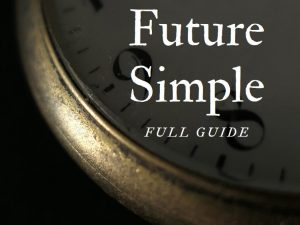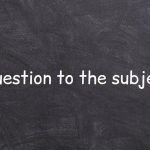To be going to means that someone will do something in the future. Or something will happen in the future.
In English, the future can be formed using such forms of the future tenses as:
But besides these forms, there are other ways how we can tell about the future.
One of these ways is called to be going to.
How to form sentences
To form a sentence with to be going to, we need:
- Subject (I, You, John, People, Dog, etc.)
- The right form of the verb to be in the present. It depends on who is the subject in the sentence:
- I am
- He is
- She is
- It is
- We are
- They are
- You are
3. going to…
4. Infinitive (buy, read, watch, meet).
All these four elements together form a sentence in which we talk about plans or intentions for the future:
We are going to talk again tonight.
We form positive, questions and negatives with be going to just like we do with the verb to be in the Present Simple:
How to form Affirmative (Positive) Sentences with to be going to
Subject (I, we, John, people, dog) + am / is / are + going to + main verb (look, buy, visit)
I am going to see Joel tonight anyway.
It is going to be a hot day today.
How to form Interrogative (Question) Sentences with to be going to
am / is / are + subject (I, we, John, people, dog) + going to + main verb (look, buy, visit)
Are you going to eat all that?
Are we going to visit him?
We can add additional question words or phrases to the question to get more information about someone’s plans. It is called Wh-questions:
question word or phrase + am / is / are + subject (I, we, John, people, dog) + going to + main verb (look, buy, visit)
What are we going to do tonight?
When are we going to visit him?
How to answer questions
How to answer a question correctly using the to be gong to?
A short answer:
Yes / No + Subject + to be (+ not if the answer is negative)
Question: Are we going to split up the money now?
Positive answer: Yes we are.
Negative answer: No, we are not.
A full answer:
Yes / No + Subject + to be (+ not if the answer is negative) + main part of the question in affirmative (positive) form
Question: Are we going to split up the money now?
Positive answer: Yes we are going to split up the money (now).
Negative answer: No we are not going to split up the money (now).
How to form Negative Sentences with to be going to
Subject (I, we, John, people, dog) + am / is / are + not + going to + main verb (look, buy, visit)
She is not going to read this book.
They are not going to play football tomorrow.
Abbreviations
In spoken English and informal writing, we contract am, is, are as follows:
| Full | Short |
|---|---|
| I am going to | I’m going to |
| He is going to | He’s going to |
| She is going to | She’s going to |
| It is going to | It’s going to |
| We are going to | We’re going to |
| They are going to | They’re going to |
| You are going to | You’re going to |
- I am going to – I‘m going to
- He is going to – He‘s going to
- She is going to – She‘s going to
- It is going to – It‘s going to
- We are going to – We‘re going to
- They are going to – They‘re going to
- You are going to – You‘re going to
He is going to ask you out.
He‘s going to ask you out.
What is “gonna”?
In spoken English and informal writing, we often use an abbreviation for the entire structure to be going to. It looks like gonna.
I’m gonna do my job.
Remember that we use this abbreviation for informal speaking. In formal speaking, we use the full form to be going to.
We use the contraction “gonna” not only in affirmative (positive) sentences but also in interrogative (question) and negative sentences.
I am not gonna do my job.
Am I gonna do my job?
You can often hear “gonna” in songs or movies.
When to use To be going to
Let’s take a look at the most common use cases of to be going to:
- We use to be going to to express plans or intentions for the future.
He is going to be alone forever.
- We use to be going to to express ambition.
He’s going to be a general someday.
- We use to be going to to predict events or actions. This prediction is based on obvious facts.
It feels just like it is going to snow …
Looks like it is going to be fun!
- We use to be going to to predict obvious events that will happen right now.
In this case, we use to be going to to say something that in our opinion will inevitably happen immediately after the moment of speaking.
Look out! The tree is going to fall!
What is the difference between To be going to and Future Simple?
We use to be going to and the Future Simple to talk about the future. What is the difference between the Future Simple and to be going to? We can talk about it for a very long time because often this difference is quite insignificant.
But the main difference is that we use to be going to when we talk about something that we have planned for the near future.
I am going to ask you something very pleasant.
Tomorrow morning, they are going to rob that store.
Or when we talk about something that will happen literally right away. About something that is almost happening.
Look at the sky! It is going to rain.
Or when we predict something based on obvious facts, signs.
We have no place where to sleep. Looks like it’s going to be a bad night.
When we report something we decided in advance. This means that we did not get the idea at the time of the speaking. We thought about this before.
I am going to buy a new car soon.
Future simple.
We use the Future Simple when our decision is spontaneous, made at the moment of speaking.
You know what? I will buy a new car!
I will order another pizza!
When you predict an event, and this prediction is not based on obvious facts (as is the case with to be going to), but on personal opinion.
It will be nice to get a shower and sleep in an actual bed.
How to use To be going to in the past
We use to be going to not only in the present but also in the past (the Future in the Past). In this case, we use to be going to to say that someone in the past intended to do something.
To use to be going to in the past, we simply change the verb to be in the structure to the past form.
If in the present the verb to be looks like this:
- I am going to
- He is going to
- She is going to
- It is going to
- We are going to
- They are going to
- You are going to
Then in the past to be has only two forms was and were:
- I was going to
- He was going to
- She was going to
- It was going to
- We were going to
- They were going to
- You were going to
Changing am / is / are to was / were we get the construction to be going to in the past:
She is going to hit me!
She was going to hit me!
We form affirmative (positive), interrogative (question), and negative sentences with to be going to in the past, just like in the present:
I was going to book a room.
I was not going to book a room.
Was I going to book a room?
We use to be going to in the past to say that someone in the past was going to do something. Only we speak about the future from the point of view of the past. It’s called the Future in the Past.
He said he was going to get headphones.
I thought we were going to buy him a drink.
The verb Go
We try not to use the verb go in the construction to be going to.
See how to be going to looks like with the verb watch:
I am going to watch this movie later.
Now look at what this construct looks like with the verb go:
I’m going to go to work.
See? The verb go in to be going to looks unclear as if we repeat the same word twice:
I’m going to go to work.
If we want to use go and to be going to together, it is better to change the verb go to another verb similar in meaning. We use instead of the verb go the place where we are going. Or we change the verb go to a verb similar in meaning that is suitable for the sentence.
Better to avoid: I am going to go somewhere.
Use instead: I am going somewhere.
Better to avoid: I am going to go to my friends.
Use instead: I am going to visit my friends.
Additional tips
Remember: To be going to is formed according to the rules of the present tense. To be going to is like the Present Continuous.
But do not forget that what we say using to be going to refers to the FUTURE.
Although the construction to be going to looks like the Present Continuous, this construction does not describe what is happening at the moment of speaking. To be going to describes what will happen in the future.
I am going to buy a new car! (in the future)










